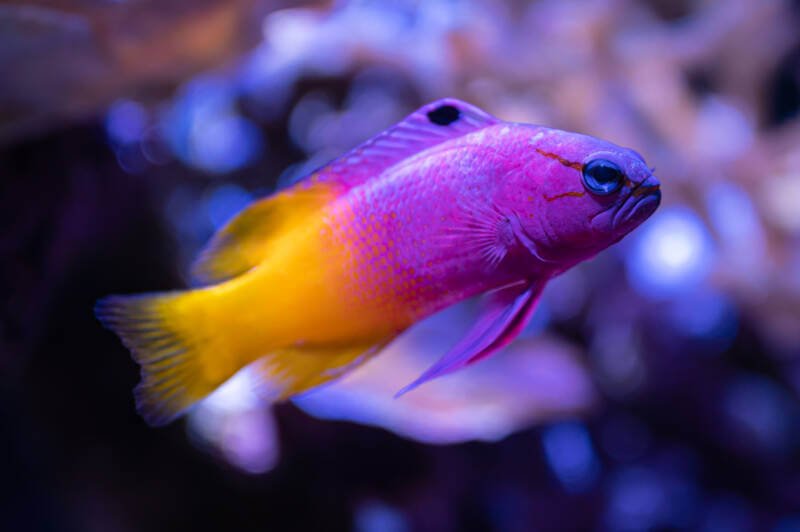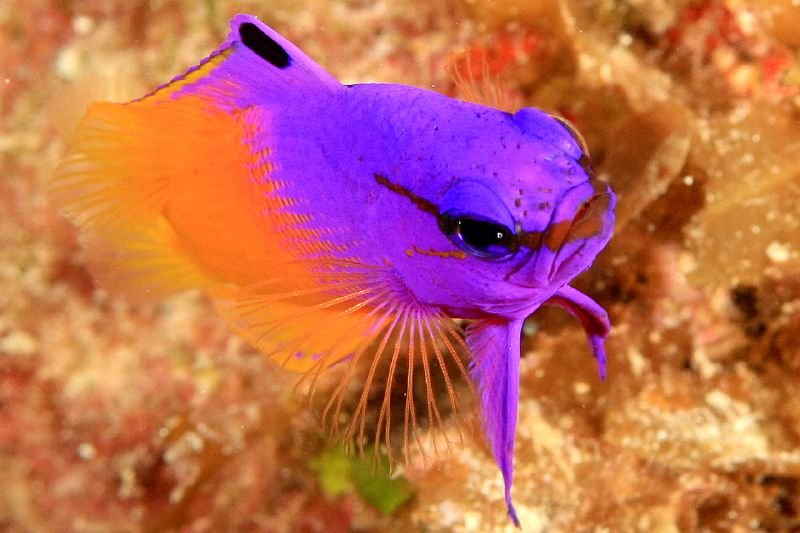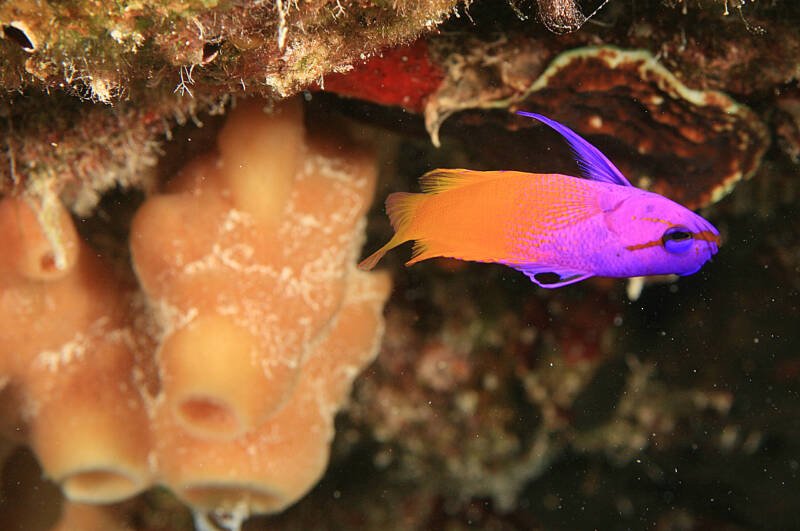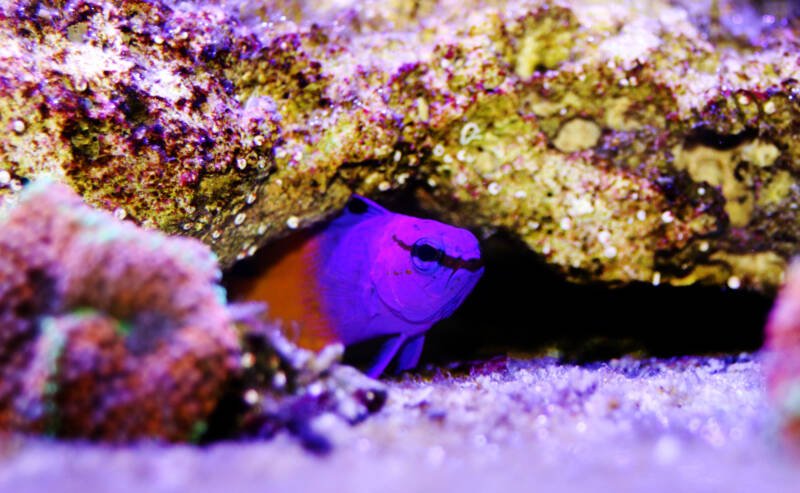If you’ve set up a flourishing saltwater aquarium, the odds are you’ve had your eyes on a royal gramma.

Also known as the fairy basslet, these are some of the most colorful saltwater fish an aquarist can find.
Shocking purple transitions to vibrant yellow in the middle of the fish, broken up in tiny dots that make for an interesting pattern. Meanwhile, a slash of black cuts from the mouth through the eye. And you often find a black spot along the dorsal fin.
Royal Grammas vs. Royal Dottybacks
It’s a striking color palette that’s mimicked (and often confused) in the royal dottyback (Pictichromis paccagnellae).

However, dottybacks have a sharp boundary between the purple and yellow. They also don’t have those black marks. And if you look closely, their fins are clear.
Royal grammas (Gramma loreto) work well with aquarists of any level. Dottybacks, on the other hand, have an aggressive streak that makes them less-than-ideal for most marine tanks.
But, as long as you’re confident in your identification, you shouldn’t have a problem managing a fairy basslet.
At a Glance
| Min tank size: | 30 gal (113 L) |
| School size: | One is safest |
| Temperature: | 72-78°F (22-25.5°C) |
| pH: | 8.1-8.4 |
| Hardness: | 8-12 dH |
| Salinity: | 1.020-1.025 |
| Ammonia: | 0ppm |
| Nitrite: | 0ppm |
| Nitrate: | 0ppm |
| Lifespan: | 5-6 years |
| Size: | 2.5-4 inches (6.4-10 cm) |
In this article
In the Wild

If you take to the tropical waters of the Bahamas, Bermuda, Lesser Antilles, and the seas of Central and northern South America, you’ll find royal grammas. They swim at depths between 6.5-197 feet (2-60 m).
While beautiful to look upon, fairy basslets don’t have the strongest swimming ability. As such, they stick to caves, coral outcroppings, and rocky overhangs.
Hiding among the rock structures, they wait for food to drift by, make a quick “sprint” to snatch it up, then dash back home.
Rather than expend a lot of energy fighting the currents in these regions, they stay close to rock work.
As such, divers often see them swimming sideways or even upside down. It’s one of the most endearing traits of royal grammas.
Size: Average Reef Fish

Royal grammas have narrow bodies designed to fit within their caves. They grow anywhere from 2.5-4 inches in length (6.5-10 cm).
You can expect to see yours reach around 3 inches (7.6 cm) in a captive setting.

Lifespan
In general, the fairy basslet is a hardy marine fish. Given a proper reef tank, a healthy diet, and limited stressors, you’ll see them live between 5-6 years.
Which isn’t that bad for a fish of this size when you think about it.
Behavior
Overall, royal grammas have a peaceful nature. They prefer to spend most of their time hiding out in their chosen caves.
On the shy side, they won’t challenge other fish – unless those fish show curiosity in their territory.
Even if a fish SHOULD come close to the rock your gramma’s picked out, the most you’ll see is a little posturing. Grammas adopt the “Gramma gape.”
This is where they open their mouths to extreme levels, attempting to make themselves appear larger than they actually are.

If the display doesn’t work, your fairy basslet will beat a hasty retreat for the rock work.
They’re too shy to engage in any official battles. The “Gramma Gape” is the most potent tool in their arsenal, and once it fails, they’ll run and hide.
That said, they ARE territorial with one another. As such, your best bet is to keep ONE royal gramma per saltwater tank. Otherwise, they’ll fight with one another for the available rock work you provide.
If you want to keep a pair, you’ll want a male-female. You’ll also need to increase the size of your tank. This allows them to define individual territories. And introducing both grammas at the same time will lessen your chance of squabbles.
Some aquarists HAVE kept harems of royal grammas. If you have sufficient room for a large marine tank, it IS possible.
Once again, you need to provide enough live rock for everyone in the school. You’ll also need to add everyone at once.
Even in captive settings, royal grammas hug rocky surfaces. As such, it’s not unusual to walk by and see your gramma swimming upside down or sideways.
Normally, this is a call for alarm. But for fairy basslets, it’s normal. They’re simply exploring the tank. You don’t need to worry.

Tank Setup

Royal grammas may not be the largest saltwater fish you’ll find (unlike some tangs).
However, you need plenty of space to install live rock and caves. That means providing a minimum of 30 gallons (113 l) for one gramma.
If you’re interested in going for a pair’s challenge, increase that size to 50 gallons (189 l).
And if you want a HAREM, you need to go all the way to AT LEAST 100 gallons (378 l). This will allow everyone to have a chosen cave while keeping stress levels low.
Regardless of your chosen school size, you’ll need to invest in a tight-fitting cover. Royal grammas may not have the best swimming ability, but they have STRONG jumping skills. When frightened, they head straight for the top of the tank – and OUT.
Since they’re not the largest fish in the world, they can find small pockets to slide out of. As such, you need to make sure you locate all of the “escape hatches” and cover them. If you don’t, you may come home to a fairy basslet on the floor.
Lighting is essential when you decide to add a royal gramma to your saltwater aquarium.
They don’t swim at the surface in reefs. As they hide out under overhangs, they prefer dimmer lighting conditions. Too much light – or too sudden of a light – can panic them.
You may want to set up two timers for your lights. This can simulate the “dusk” hour the grammas would experience in the wild.
Use a slightly less powerful light with your daytime lights, and let it run for an hour longer. Your grammas will appreciate the transition.
Water Conditions
As tropical species, you want to keep your royal grammas in a warm environment. They prefer temperatures between 72-78°F (22-25.5°C).
You also want to keep your specific gravity between 1.020-1.025 so they have the proper salinity levels.
Odds are, you already have soft polyp stony (SPS) or large polyp stony (LPS) corals in your reef tank.
This means you’re keeping track of your pH and hardness for their health. Grammas appreciate a pH range between 8.1-8.4 and a hardness of 8-12 dH, which is also coral-approved.
Decorating Royal Gramma Tank
The essential element of a royal gramma tank is live rock.
You want to simulate the deep-water outcroppings they favor in the wild. And you’re trying to provide hiding places that make them feel comfortable.

Laying down live sand as your substrate, then adding in live rock piles with crevices and caves your fairy basslet can explore and retreat into will do the trick. You’ll also provide plenty of food opportunities for the fish, making it a win-win situation.
If you don’t want to worry about managing live rock, you CAN opt for artificial rocks.
Resin holds up in marine tanks without a problem. Aquarium glue will hold the resin together. Let everything dry FIRST, though. You don’t want an accidental collapse to hurt your grammas.
Royal Grammas in Communities
With their peaceful temperaments, royal grammas do well in saltwater communities.
And since they prefer to spend most of their time hiding out, you don’t need to worry they’ll destroy your work in a reef tank. It makes them the perfect colorful addition.
Tank Mates
Royal grammas are reef-safe fish. They don’t nibble on sea anemones OR corals. And, for the most part, they’ll leave shellfish alone. Their natural environment IS the reef, and they play nicely with the residents found there.
You can safely mix them with most similar-sized saltwater species – provided they’re not aggressive. After all, the “Gramma Gape” doesn’t fool everyone. These fish work well with fairy basslets:
- Angelfish
- Boxfish
- Cardinalfish
- Chromis
- Clownfish
- Filefish
- Gobies
- Jawfish
- Hawkfish
- Rabbitfish
- Squirrelfish.
Incompatible Species
If you have a marine tank full of large, aggressive fish, the royal gramma will end up frozen in terror inside its cave.
You’re better off skipping them in the mix. They’ll try the intimidation route, but they’ll likely end up chased away – or eaten.
Instead, skip mixing rougher brutes with these smaller treasures. As examples, you’ll want to avoid the following fish if you have a community with royal grammas:
- Assessors
- Dottybacks
- Damselfish
- Dwarf lionfish
- Snowflake eels.
Officially, grammas don’t eat invertebrates. They’ll leave your cleaner shrimp alone. However, they may take nips at smaller crustaceans (such as hermit crabs).
And they can’t help investigating turbo snails. Mix these guys with caution.
Food and Diet
Royal grammas are omnivores, but they prefer their meals in the plankton size.
If given a chance, they’ll step into the cleaner line-up and remove parasites from larger (peaceful) fish. It makes them one of the LEAST picky saltwater fish out there.
You can get away with offering them commercial fish foods, though that shouldn’t be their ENTIRE diet. You need to provide various high-quality options, especially if you want to preserve their vibrant colors.
Try mixing in frozen or live protein options. You don’t have to worry about mimicking the plankton size, either. Remember, they have BIG mouths (when they want to). Gramma favorites include:
- Brine shrimp
- Crustacean flesh
- Mysid shrimp.
Grammas do best on multiple feedings a day. You should enjoy the process, too, since you’ll get to see them make a quick dash from the live rock to snatch the morsel.
If need be, though, you can condition them to once-daily feedings.
Breeding your Royal Gramma: Sequential Hermaphrodites
Breeding fairy basslets in captivity isn’t the most challenging task in the world.
It’s figuring out whether you have males or females that gets tricky – and then raising the fry. This is a saltwater species that are sequential hermaphrodites.
All royal grammas are born female. In the wild, the most dominant member in an area will change to a male. However, if you don’t have a harem, you won’t have control over this occurrence. It makes the breeding process trickier.
Males or Females?
Once that sex change occurs, it’s still a little challenging to tell a male from a female.
Males increase in size, and their ventral fins stretch out. They also take on brighter colors. But when you have a fish already known for vibrant scales, this can get challenging to pick out.
Algae Nests
In the wild (and in captive reef tanks), royal grammas start spawning in spring and summer. Waters get warmer during this period – something you can induce artificially.
Over several months, spawning occurs EVERY day, which increases your chances if you want to give it a try.
Males build nests out of rocks and algae. The females then inspect the work and lay their eggs in the resulting nest.
A female can lay anywhere from 5-40 eggs (not much), and they stick to the algae. The male then fertilizes the eggs within the nest.
After 5-7 days, the eggs hatch, usually in the evening. Which is when things get problematic. Remember, eggs get laid EVERY day. So they also hatch EVERY day. You end up with a tank of gramma fry of different sizes – with varying sizes of mouth.
Your best bet is to keep a ready supply of copepods and rotifers on-hand for the smallest fry.
Once they get larger, you can transition them to newly-hatched brine shrimp. It’s a slow process and one that takes days to work on – especially if you have a harem.
Hardiness and Diseases
Overall, royal grammas fall on the healthy side of the spectrum. It’s one of the reasons they appeal to aquarists of all levels.
Add in that those colors start to fade as soon as water quality slips, and these “indicator fish” really gain appeal.
But they’re not “bulletproof.” Grammas often develop marine ich. Cryptocaryon irritans is the parasite responsible in the saltwater world, and it pops up the white spots you see in the freshwater version of the disease.
Untreated, marine ich progresses to wasting of the body, excessive mucus production, and respiratory distress.
And while you CAN find over-the-counter treatments, reef tanks make them tricky to administer because they contain copper – which will kill your invertebrates.
If you notice signs of marine ich on your fairy basslet, transfer it to a quarantine tank immediately. There you can administer treatment safely. But the process is SLOW – up to nine weeks. The cysts of the parasite take THAT long to die.
Royal Grammas: Are they for You?
Depending on the size of the royal gramma you’re interested in, you can expect to pay between $20-$30.
Which isn’t terrible unless you have your eyes set on a harem. After all, odds are you already have the marine tank set up and cycled.
Look carefully at the fish within the tank, though. You don’t want to bring home a royal dottyback accidentally.
The dottyback won’t behave like the gramma, leading to aggression and bullying within the community – which you’re not going for.
True Treasures of the Caribbean
With the dynamic color change on their scales, royal grammas are little treasures found throughout the Caribbean waters.
They’re peaceful in nature, making them perfect for all aquarists. And they have a hardy nature that’s appealing – with the proper live rock tank set-up.
Do you have royal grammas? Have you ever considered keeping a harem?
Do you use live rock or resin?
Share your stories and questions with us here!